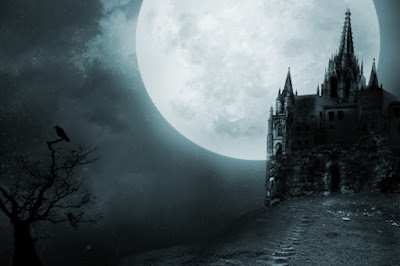Gothic fiction (2016) in Wikipedia. Available at:
https://en.wikipedia.org/wiki/Gothic_fiction#Post-Victorian_legacy (Accessed: 2 February 2016).
 |
| First edition of 'The Castle of Otranto, published in 1765 |
Gothic novel the castle of Otranto, by Horace Walpole, with a watercolour drawing (no date) Available at: http://www.bl.uk/collection-items/gothic-novel-the-castle-of-otranto-by-horace-walpole-with-a-watercolour-drawing (Accessed: 2 February 2016).
‘There were a lot of Gothic ruins lying around Britain, and people in the 18th and 19th centuries developed an interest in them because (a) ruins are always kind of mysterious and melancholy and creepy and (b) they evoked the time period they were built in, which was thought of as a barbaric time where people believed in (and did) all kinds of weird stuff. For this reason, most early Gothic horror novels were set in that era. They were usually also set in Catholic countries, because the Brits who wrote them considered Catholicism sinister.'
Gothic horror (no date) Available at:
http://tvtropes.org/pmwiki/pmwiki.php/Main/GothicHorror (Accessed: 2 February 2016).
‘Meanwhile Gothic had become so influential that we can detect its elements in much mainstream Victorian fiction. Both Emily and Charlotte Brontë included intimations of the supernatural within narratives that were otherwise attentive to the realities of time, place and material constraint. In the opening episode ‘Wuthering Heights’, the narrator, Lockwood, has to stay the night at Heathcliff’s house because of heavy snow. He finds Cathy’s diary, written as a child, and nods off while reading it. There follows a powerfully narrated nightmare in which an icy hand reaches to him through the window and the voice of Catherine Linton calls to be let in. The vision seems to prefigure what he will later discover about the history of Cathy and Heathcliff. Half in jest, Lockwood tells Heathcliff that Wuthering Heights is haunted; the novel, centred as it is on a house, seems to exploit in a new way the Gothic idea that entering an old building means entering the stories of those who have lived in it before.’
The origins of the gothic (no date) Available at:
http://www.bl.uk/romantics-and-victorians/articles/the-origins-of-the-gothic (Accessed: 2 February 2016).
Movieclips Coming Soon (2012) Wuthering heights TRAILER (2012) - Sundance movie HD. Available at: https://www.youtube.com/watch?v=3-b0DBepmgo (Accessed: 2 February 2016).
Gothic elements include the following:
‘Setting in a castle – the action often takes place in and around an old castle, sometimes seemingly abandoned, sometimes occupied. The castle often contains secret passages, trap doors, secret rooms, trick panels with hidden levers, dark or hidden staircases, and possibly ruined sections. The castle may be near or connected to caves, which lend their own haunting flavour with their darkness, uneven floors, claustrophobia, and mystery. And in horror-gothic, caves are often seemed home to terrifying creatures such as monsters, or deviant forms of humans: vampires, zombies, wolfmen. Translated into the modern novel or filmmaking, the setting might be in an old house or mansion, or even a new house where unusual camera angles, sustained close ups during movement, and darkness or shadows create the same sense of claustrophobia and entrapment. The house might be already dark, perhaps because it was abandoned, or it might at first seem light and airy. The goal of the dark and mysterious setting is to create a sense of unease and foreboding, contributing toward the atmospheric element of fear and dread. Darkness also allows those sudden and frightening appearances of people, animals, or monsters.
An ancient prophecy – connected with the castle or its inhabitants. The prophecy is usually obscure, partial, or confusing.
Omens portents, visions – a character may have a disturbing dream vision, or some phenomenon may be seen as a portent of coming events. In modern fiction, a character might see something and think that it was a dream. This might be thought of as an "imitation vision." Sometimes an omen will be used for foreshadowing, while other writers will tweak the reader by denying expectation.
Supernatural or otherwise inexplicable events – dramatic, amazing events occur, such as ghosts or giants walking, or inanimate objects coming to life. In some works, the events are ultimately given a natural explanation, while in others the events are truly supernatural.
High, even overwrought emotion – the narration may be highly sentimental, and the characters are often overcome by anger, sorrow, surprise, and especially, terror. Characters suffer from raw nerves and a feeling of impending doom. Crying and emotional speeches are frequent. Breathlessness and panic are common. In the filmed Gothic, screaming is common.
Women in distress – as an appeal to the pathos and sympathy of the reader, the female characters often face events that leave them fainting, terrified, screaming, and/or sobbing. A lonely, pensive, and oppressed heroine is often the central figure of the novel, so her sufferings are even more pronounced and the focus of attention. The women suffer all the more because they are often abandoned, left alone and have no protector at times.
Women threatened by a powerful, impulsive, tyrannical male – one or more male characters has the power, as king, lord of the manor, father, or guardian, to demand that one or more of the female characters do something intolerable. The woman may be commanded to marry someone she does not love or commit a crime. In modern Gothic novels and films, there is frequently the threat of physical violation.
The metonymy of gloom and horror – metonymy is a sub-type of metaphor, in which something is used to stand for something else. For example, the film industry likes to use metonymy as quick shorthand, so we often notice that it is raining in funeral scenes.
The vocabulary of the Gothic - the constant use of appropriate vocab set creates and sustains the atmosphere of the Gothic. Using the right words maintains the dark-and-stimulated feel that defines the gothic.’
Elements of the gothic novel (no date) Available at:
http://www.virtualsalt.com/gothic.htm (Accessed: 2 February 2016).
Hill, S. (2015) A gothic horror story of quicksands, riptides and rituals. Available at: http://www.spectator.co.uk/2015/08/a-gothic-horror-story-of-quicksands-riptides-and-rituals/ (Accessed: 2 February 2016).

No comments:
Post a Comment